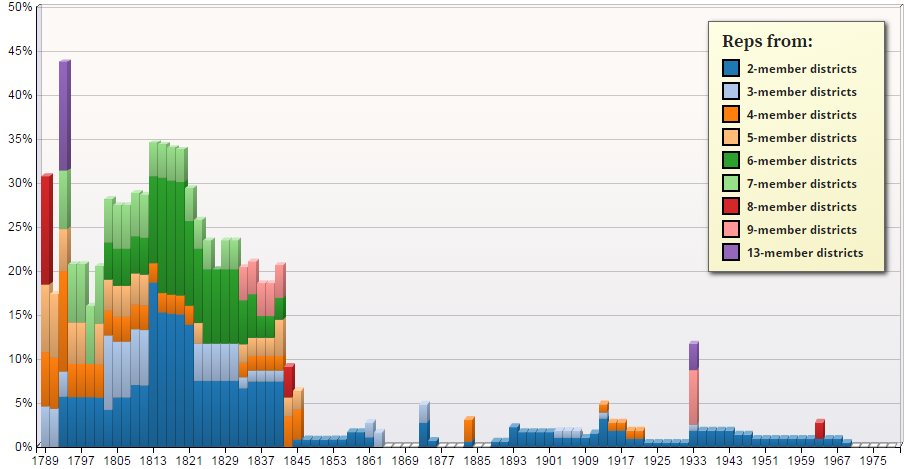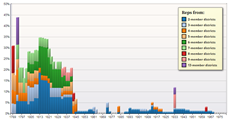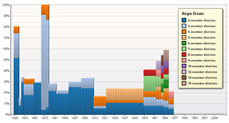Americans are used to electing our representatives from single-member districts. Since the 1970s, all members of the US House of Representatives have been elected this way. But in many cases prior to that, states elected some or all of their federal representatives from multimember districts, where two or more people represented the same geographical area.
In 1967, Congress passed a law mandating that all states use single-member districts for elections to the House of Representatives. Hawaii and New Mexico, the only two states at the time that elected multiple representatives at large, were given a one-time exemption for the 1968 election.
Two factors motivated the passage of this mandate. The first was that the courts had become more active in imposing redistricting requirements, and seemed ready to insist on at-large elections for states that failed to reapportion in accordance with court orders — a prospect incumbents from single-member districts saw as threatening to their careers.
The second motivating factor was to avoid the dilutionary impact on the black vote of at-large voting. Traditional at-large elections tend to overrepresent the majority, since each seat is decided separately by all the voters — so, a majority interest group of 50% can determine 100% of the seats. (With regard to this flaw, the system is similar to single-member-district plurality voting — only worse.) This “sweep” effect was well-known at the time, and many Southern states had already started to use at-large voting to dilute minority voters’ impact in response to the Voting Rights Act of 1965.[1]
For the 92nd Congress (1971-73) and beyond, all congressional districts have been single-member, as shown in the chart below (which ends with the 96th Congress to save space). Position your mouse over the bars to get more information about the makeup of that Congress. For bars corresponding to districts with 5 or more reps, you can also click to see further details. (Note that a district may be an entire state.)
Source: Martis, Kenneth C., The Historical Atlas of United States Congressional Districts, 1789-1983, Free Press, 1982.
A big decline in multimember district representation followed an 1842 apportionment act of Congress, which was the first time it had instructed the states how to conduct their federal elections.[2] Enforcement was lacking, however; when states elected representatives from multimember districts (MMDs), they were allowed to take their seats.
At the state level, MMDs have been even more common, and continue to be used in ten states, according to Ballotpedia. One such state is Maryland, where three representatives are elected to the lower house from each of 47 districts (although some are subdivided into single-member districts).[3]
In a 1955 article, political scientist Maurice Klain reported that 36 of the 48 states had some multimember districts. Of all the seats in the lower houses of those 36 states, 58% were occupied by representatives elected from MMDs. (Oddly enough, before this paper’s publication, many political scientists seem to have considered single-member districts the norm in state legislatures. This should remind us of the importance of questioning assumptions.)[4]
In Texas (my home state), MMDs were used extensively from 1846 until the mid-1970s. Districts usually corresponded to counties or combinations thereof, with more populous counties getting more representatives. From time to time, flotorial (a.k.a. floterial) districts were used: these were districts which overlapped with other districts, to give representation to a county or region that otherwise would not get any. In the chart below, flotorial districts are treated as separate districts without regard to overlap. (Generally speaking, flotorials were single-member, in Texas.)
Sources: Members of the Texas Congress 1836-1845; Members of the Texas Legislature 1846-2004, Texas Senate, 2005; “Overview: Texas House Districts, 1846-1982”, Texas Legislative Council; “Texas Legislators: Past & Present”, Legislative Reference Library of Texas.
Although the idea of equal representation surely always held conceptual appeal, it was not until 1964 that the Supreme Court insisted on the “one person, one vote” principle for state legislative districts, in the landmark Reynolds v. Sims decision. This and other court decisions, and difficulties developing a district plan that would pass muster, led to the exclusive use of single-member districts in Texas after 1975.
* * *
The march of history clearly has favored single-member districts, at both the federal and state levels. But are they indisputably better? I think not. They mean that only the majority view within a district will be represented. But shouldn’t minority views also have some representation, in proportion to their strength?
In a proportional representation (PR) system, if a minority party gets 10% of the vote, then it gets 10% of the seats, subject to rounding: in a 10-member district, it would mean one seat, while in a three-member district, it would fail to meet the threshold for a seat. John Adams, in his Thoughts on Government (1776), lauded the goal of proportionality in government:
The principal difficulty lies, and the greatest care should be employed in constituting this Representative Assembly. It should be in miniature, an exact portrait of the people at large. It should think, feel, reason, and act like them. That it may be the interest of this Assembly to do strict justice at all times, it should be an equal representation, or in other words equal interest among the people should have equal interest in it.[5]
The only straightforward way to implement PR is with multimember districts, and by establishing this system, we would avoid the big problem of the plurality at-large system — its tendency to overrepresent the majority and suppress minority interests. Unfortunately, it seems that the virtues of PR were not widely recognized during most of our history. (Arguably its most sophisticated version, the single transferable vote system, was invented in the 1850s, independently by Carl Andræ and Thomas Hare. By that time the momentum in the US seems to have swung solidly in favor of single-member districts.)
If we, as a nation, ever decide to expand our two-party system to a multiparty one, PR would be an excellent reform to adopt. We would need to convince Congress to repeal the 1967 mandate — not easily done, of course — and then get our states to adopt it — also difficult. But it surely will help to know about our long history with MMDs — and how to avoid the problems we had with them in the past.
Notes:
[1] Flores, Nicolas, A History of One-Winner Districts for Congress, undergraduate thesis, Stanford University, 1999; chapter 4. Available online at http://archive.fairvote.org/library/history/flores/district.htm
[2] Mast, Tory, “History of Single Member Districts for Congress: Seeking Fair Representation Before PR”, FairVote. http://archive.fairvote.org/reports/monopoly/mast.html
[3] Schaller, Thomas F., “Multi-Member Districts: Just a Thing of the Past?”, Sabato’s Crystal Ball, March 21, 2013. http://www.centerforpolitics.org/crystalball/articles/multi-member-legislative-districts-just-a-thing-of-the-past/
[4] Klain, Maurice, “A New Look at the Constituencies: The Need for a Recount and a Reappraisal”, American Political Science Review, Vol. 49, No. 4 (December 1955), pp. 1105-1119.
[5] Adams, John, Thoughts on Government, 1776. Available online at http://press-pubs.uchicago.edu/founders/documents/v1ch4s5.html


